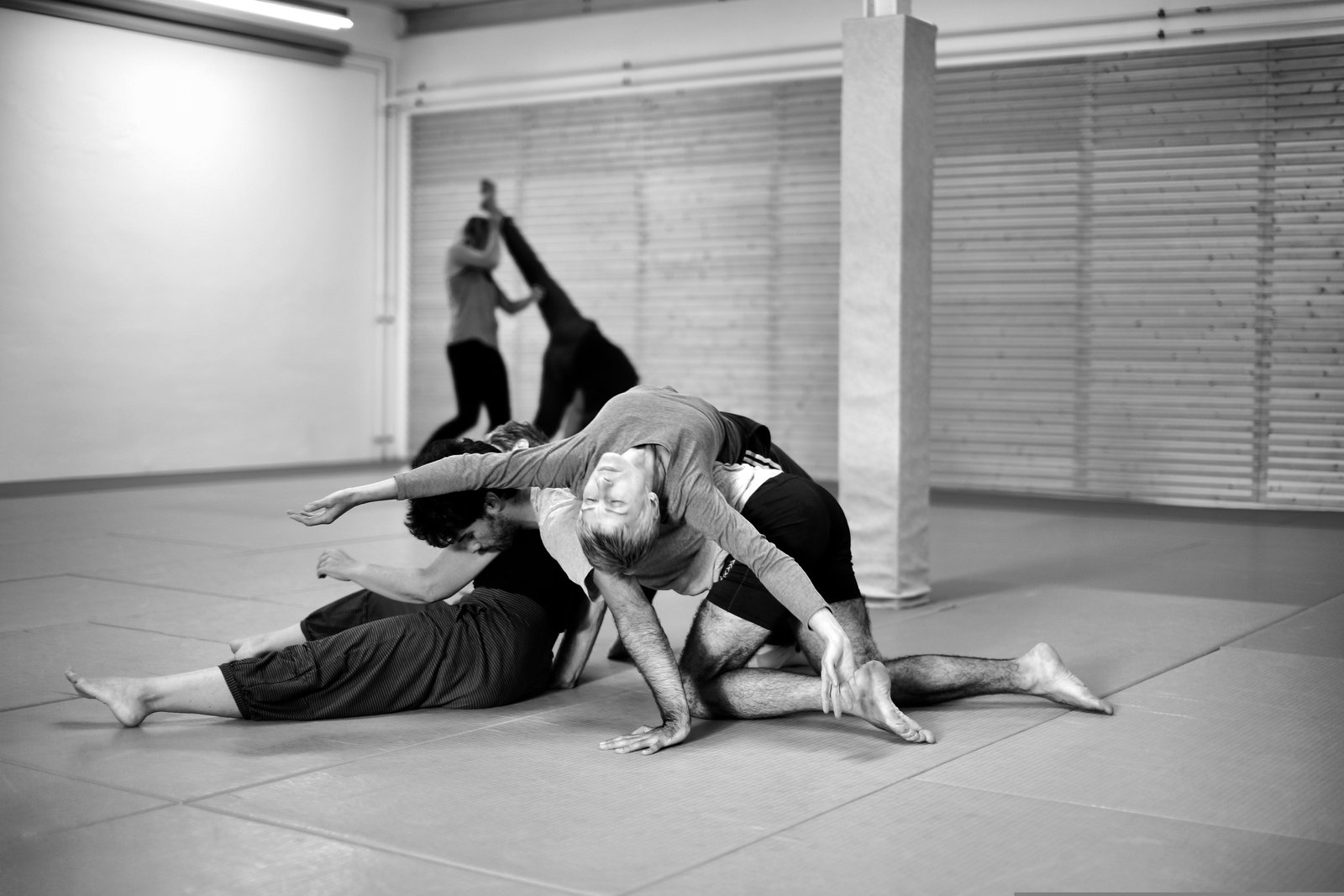Contact Dance Improvisation is opened to everyone.
It is a dance initiated by the American choreographer Steve Paxton in 1972, where dancers come into contact with each other, jump on each other, roll on the floor and fall in the air. This practice does not seek to be an aesthetic dance. We come with our body, with its tensions, with its potential, with its blockages, with its strengths, with the single aim of living the dance so that it conveys as sincerely as possible the connection between the bodies that meet as they are at that moment.
It is important to eliminate any psychological, social or sexual connotations from the movements: the essence of this practice lies in the absence of any judgmental thought in order to favour an approach of the body free of all taboos.
This practice is open to absolutely all bodies. Whether they have a limited motor capacity or not, whether they are not or very flexible, whether they have experience in other body practices or not.
Offer the weight of your body without surrendering to the body of the other.
A key part of this is to focus on experiencing the other one’s gravity when touching them.
At the contact of bodies and focusing on a common centre of gravity, people are open to listen to their their perceptions of the other’s body, as well as to their own body through the mediation of their partner’s body.
This depends on how the individual experiences their weight.
People entrust their weight to each other, without entrusting all of it to their partner: each modulates the weight they entrust to the other in proportion to what they receive from it. A dancer can only offer their weight if their partner is strong enough to receive it.
A perpetual exchange between the weight of one another appears, without being possible to really determine who is leading the dance.
This practice looks for imbalance and impact, in order to shake up the classical reference points of gravity by soliciting spontaneous and unthinking gestural reactions through falls, bodily encounters, involuntary physical reactions, with the aim of expressing what is in the body before any culture.
This journey allows the body to gather new emotions, to awaken new sensations, to experience new ways of communicating in order to enrich our sensitivity, the one of a body that constitutes us.
Some characteristics of the technical elements and the perceptive bases.
Support, fall, spiral and inversion.
The supports are based on the action of giving the weight of one’s own body and receiving the weight of the partner’s body, on various body zones.
The falls are described as a vertical transfer of weight from different areas of the partner’s body to the ground; thus the falls are transformed from a vertical moment to a horizontal movement. Finally the sensation of falling to the ground is no longer an encounter with the void but a journey where the partner’s body, which partly supports our weight, invites us to meet the ground in a spontaneous way.
Spirals are continuous movements that allow us to mix the different support points around the other’s body as an axis. Spiral movements are also recognised as an organic and intuitive type of movement compared to horizontal and vertical movements.
In inversions there is a change in the axis of the body and its postural reference as well as a loss of contact with the ground. It can occur as a quick transition or as a longer exploration at different heights from the ground, the possibilities are endless.
Balance, touch and peripheral vision.
Balance involves a permanent adjustment of the receptors between the hearing and the joints. In this case, unlike other movement techniques, balance is relative to the part of the body that carries the weight, which can be the feet, shoulders, back, head…
Touch is obviously one of the key senses that dancers use to communicate multiple information such as their general state, their contact with the floor…
Peripheral vision allows us to constantly orient ourselves in relation to the outside despite not being in contact with the floor, as well as independently of our body axis.
And finally :
The most important thing is to meet the balance, to trust the intelligence of the body, and to let go of the control of it, which will allow us to open the possibility of exploring and meeting organic movement sequences, born by the simple fact of letting the connection between two bodies dance.

Articles
Vertical Dance
This discipline, born from the encounter between climbing and dance, started to grow in the 1970s and 80s. The fundamentals of vertical dance are mainly based on one of the essenti

Articles
Contact Dance Improvisation
Contact Dance Improvisation is opened to everyone. It is a dance initiated by the American choreographer Steve Paxton in 1972, where dancers come into contact with each




